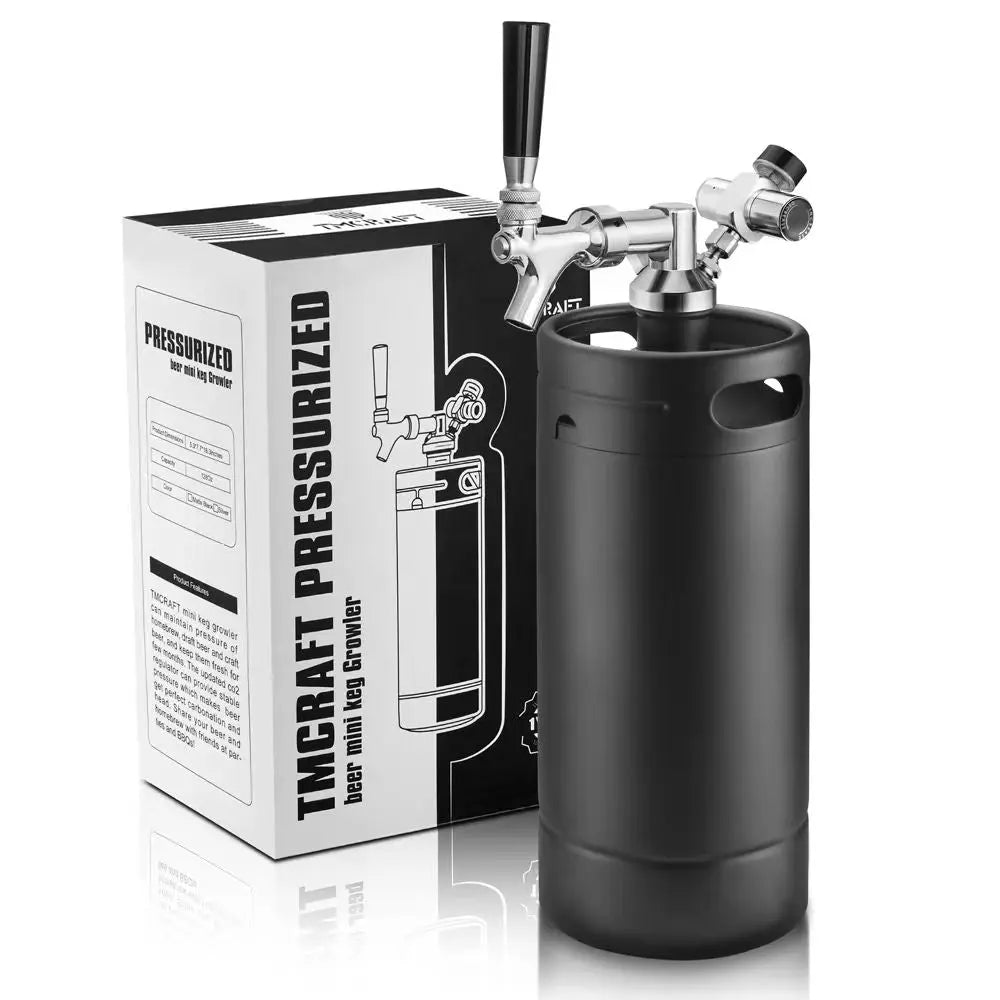Mini Kegs 101: Everything You Need to Know About Portable Beer Kegs for Homebrewing
 Targets: Mini Keg, Portable Beer Keg, Fresh Beer, Homebrewing Gear, TMCRAFT Mini Kegs
Targets: Mini Keg, Portable Beer Keg, Fresh Beer, Homebrewing Gear, TMCRAFT Mini Kegs
If you love sharing your beer—and hate washing bottles—mini kegs are the sweet spot between growlers and full kegerators. They keep fresh beer on tap, travel easily, and plug right into your existing homebrewing gear. This guide breaks down how mini kegs work, what to buy, and how to set up your system so every pour tastes like it came straight from the brewery.
What is a Mini Keg?
A mini keg is a compact, pressurizable stainless-steel vessel (typically 64 oz / 1.9 L to 2.6 gal / 10 L) that stores, carbonates, and dispenses beer. Think of it as a portable beer keg: small enough for the fridge, tough enough for the campsite, and compatible with CO₂.
Why homebrewers love them
- Draft beer taste without a full kegerator
- Far less oxygen exposure vs. bottles/growlers
- Fast setup, easy cleaning, and great portability
Mini Keg vs. Growler vs. Bottles
| Feature | Bottles | Glass/SS Growler | Mini Keg |
|---|---|---|---|
| Freshness after opening | Low | Medium | High (pressurized) |
| Carbonation control | Low | Low/Medium | High (CO₂ regulator) |
| Portability | Medium | High | High |
| Setup & cleanup | High effort | Low/Medium | Low |
| Draft-like pour | No | Sometimes | Yes |
Bottom line: If you want fresh beer from first pour to last (and fewer bottling days), go mini keg.
Core Components (Know Your Parts)
- Keg body (304 stainless steel): Insulates and protects your beer.
- Lid/cap with dip tube: Airtight seal; draws beer from the bottom for clear pours.
- Gas post or cartridge port: Accepts 16 g CO₂ cartridges or connects to a CO₂ tank.
- Regulator: Sets pressure for carbonation and serving.
- Tap/faucet: Picnic tap or tower-style for smooth dispensing.
- Optional nitro/air systems: For stouts or cold brew coffee.
TMCRAFT Mini Kegs are built around these parts with tight tolerances and rugged finishes, so leaks and flat pours are far less likely.
Choosing the Right Size
- 64 oz (1.9 L): Perfect for fresh IPA on the go or sharing a couple pints.
- 128 oz / 1 gallon (3.8 L): Weekend trips, small parties, or split-batch experiments.
- 2.5–3 gallons (9.5–11.4 L): Event-ready capacity while still fridge-friendly.
Pro tip: If you brew 5-gallon batches, two 2.5–3 gal mini kegs let you split a batch for different dry hops or carb levels.
Carbonation: Two Easy Paths
1) Force Carbonation (fast & precise)
- Chill the beer to ~36–40°F (2–4°C).
- Set regulator to 10–15 PSI for 2–3 days (“set & forget”), or 25–30 PSI for 12–24 hours (quick carb).
- Drop to serving pressure (8–12 PSI) for pouring.
2) Natural Carbonation (traditional)
- Dose priming sugar (use a calculator), fill, seal, and condition warm for 1–2 weeks.
- Chill, vent if needed, and serve at 8–12 PSI.
Force carb = speed + repeatability. Natural carb = classic feel, slightly more variable.
Step-by-Step: First-Time Setup
- Clean & sanitize keg, dip tube, tap, and lines.
- Cold crash your beer and transfer carefully (closed transfer if possible).
- Purge with CO₂ (quick bursts) to minimize oxygen pickup.
- Carbonate (see methods above).
- Serve cold at 8–12 PSI through 5–10 ft of 3/16" line for smooth pours.
- Store chilled; keep pressure on between sessions to lock in freshness.
Serving & Pressure Tips (Zero-Foam Goal)
- Warm beer = foam. Keep keg, lines, and faucet cold.
- Too foamy? Lower PSI 1–2 clicks, lengthen line, or chill more.
- Flat? Check PSI, chill, and gently rock the keg to absorb CO₂.
- Outdoor events: pair an insulated sleeve or cooler with ice packs.
Cleaning & Maintenance (5-Min Routine)
After a keg kicks:
- Rinse with warm water.
- Circulate a no-rinse cleaner through lines and faucet.
- Rinse again; then run sanitizer.
- Air-dry inverted; store with lid off to avoid trapped moisture.
- Inspect O-rings; replace if nicked or flattened. Keep a spare kit handy.
Troubleshooting Quick Hits
- Slow leak / losing pressure: Spray soapy water on fittings—bubbles = leaks. Reseat or replace O-rings.
- No pour: Check that gas is on, regulator isn’t empty, dip tube isn’t clogged.
- Metallic off-flavor: Inadequate cleaning or new-keg residue—deep clean and rinse.
Why TMCRAFT Mini Kegs?
- 304 Stainless build: Flavor neutral, tough, and easy to sanitize.
- Tight seals & machining: Fewer leaks, consistent pressure.
- Compact footprints: True portable beer keg performance—fridge, cooler, or campsite.
- Flexible regulators: CO₂ cartridges for grab-and-go, or hook up to your main tank at home.
They’re engineered to deliver taproom-quality pours anywhere—exactly what homebrewing gear should do.
Buyer’s Checklist
✅ Food-grade 304 stainless steel
✅ CO₂ compatibility (16 g cartridges and/or tank hookup)
✅ Quality regulator with fine control
✅ Proper line length & a smooth, cleanable faucet
✅ Spare O-rings & poppets
✅ Insulation or sleeve for travel use
Great Use Cases
- Fresh IPA Fridays: Keep hops bright with low O₂ exposure.
- Split-batch trials: Same wort, different dry hops or yeasts.
- Events & travel: BYO draft bar without lugging a full system.
- Beyond beer: Seltzer, cocktails-on-tap, kombucha, and nitro coffee.
The Takeaway
Mini kegs give you draft quality, real portability, and week-long freshness—with setup and cleanup measured in minutes, not hours. If you’re ready to upgrade from bottles or want great beer beyond your home bar, TMCRAFT Mini Kegs are the most efficient path to perfect pours anywhere you go.
Ready to build your portable draft kit? Start with a stainless mini keg, a dependable regulator, and a clean faucet—and enjoy fresh beer from first pour to last.

